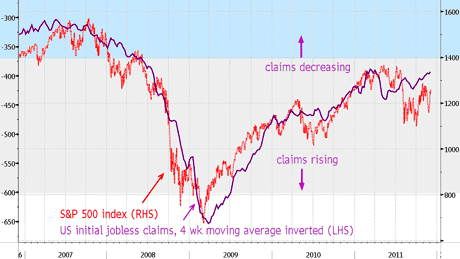Job indicators are good guides to how well an economy is really doing. More people working means extra spending and growth, and likely higher share prices, too. But if dole queues get longer, an economy and many of its businesses will suffer.
US ‘initial jobless claims’ (IJC) show how many Americans are claiming state unemployment benefits for the first time. The lower the figure, the better the news for the economy – and also the stock market. The four-week moving average of IJCs, which filters out the weekly ‘noise’, has generally been a handy pointer to both.
For the week to 3 December, IJCs dropped by 23,000 to 381,000, much better than expected. The IJC four-week moving average dipped by 3,000 to 393,250, the lowest level since early April.
What does this mean for stocks? Here’s our regular chart…

Source: Bloomberg
The purple line is the inverted IJC four-week moving average. The higher this goes on the chart, the fewer claims are being submitted. So a rising purple line is good news, and a falling line bad news. The red line is the S&P 500 index, the world’s most widely watched stock market index.
And the IJC four-week moving average continues to call the market right. It forecast the fourth-quarter rebound. Now the IJC suggests the S&P will keep recovering.
Category: Economics

